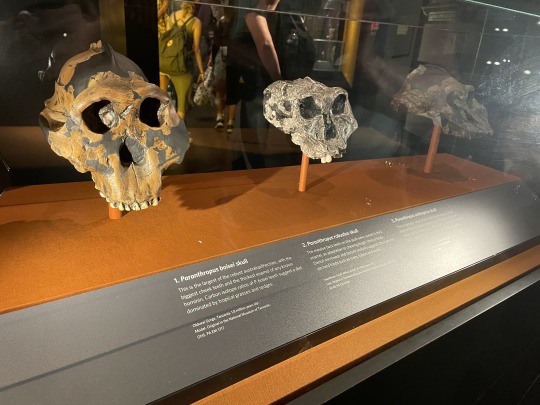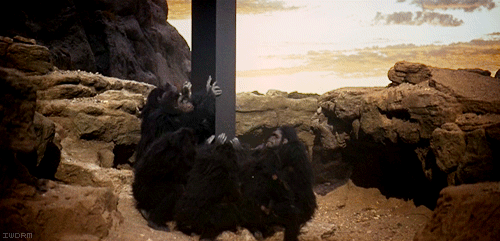#human ancestors
Text
A team of paleontologists at the Chinese Academy of Sciences, working with colleagues from Xi'an Jiaotong University, the University of York, the University of Chinese Academy of Sciences and the National Research Center on Human Evolution, has found evidence of a previously unknown human lineage. In their study, reported in Journal of Human Evolution, the group analyzed the fossilized jawbone, partial skull and some leg bones of a hominin dated to 300,000 years ago.
The fossils were excavated at a site in Hualongdong, in what is now a part of East China. They were subsequently subjected to both a morphological and a geometric assessment, with the initial focus on the jawbone, which exhibited unique features—a triangular lower edge and a unique bend.
The research team suggests that the unique features of the
jawbone resemble those of both modern humans and Late Pleistocene hominids. But they also found that it did not have a chin, which suggests that it was more closely related to older species. They found other features that resemble hominins of the Middle Pleistocene, which, when taken together, suggested the individual most resembled a Homo erectus species. And that, they conclude, suggests a hybrid of modern human and ancient hominid.
Continue Reading
254 notes
·
View notes
Text
In a remarkably short time Homo sapiens left Africa and populated every continent. By looking at fossils and archaeological evidence this video traces their fascinating journey.
22 notes
·
View notes
Text

Human Ancestors Bottleneck: a human genomics analysis has shown that the total population of direct-line human ancestors plummeted to about 1,280 breeding individuals for a span of about 117,000 years, bringing them close to extinction:
#history#historyfiles#archaeology#hominid chronology#africa#genomics#homo ergaster#human ancestors#early humans#bottleneck#extinction#extinction event#archaeological
7 notes
·
View notes
Text
Having emotions about Homo naledi again. The Killer Ape hypothesis was so wrong. Humans have always been ridiculously social and cooperative and caring and that is the FOUNDATION of who we are as a species. Naledi is one of the oldest members of the genus Homo and there is evidence suggesting they buried their dead even though they had teeny tiny brains barely bigger than chimps'. We didn't think burials happened more than like 100,000 years ago and then along comes naledi like 100,000+ years earlier. Burying their dead in such a ridiculously complicated, over-the-top difficult manner. (For the unaware, all known Homo naledi remains come from Rising Star Cave, where archaeologists had to reach the fossils by climbing down a 12m vertical chute, among other obstacles. Said chute is only 18cm wide in some places. Fucking ridiculous.)
#homo naledi#the genus homo#anthropology#human ancestors#hominins#rising star cave#if anyone wants to know why its thought to be an example of burial rather than accidental deposition i have a detailed rant prepared#hylian rambles#death tw
2 notes
·
View notes
Photo



Disciple is so cute ଲ(ⓛ ω ⓛ)ଲ
#homestuck#homestuck ancestors#humanstuck#human#human ancestors#the disciple#disciple#the sufferer#the signless#kankri vantas#meulin leijon#90s#humanization
29 notes
·
View notes
Text

You've seen bedhead now get ready for deadhead
To thank everybody who's keeping up so far and to celebrate Chapter 8--it's Pine from Cecelia and the Living Fossils! Exactly what he is and where he comes from is still a mystery . . .
#mr. 2head himself#he is not thrilled to be dealing with all this dinosaur nonsense#he just wants to go back to sleep#cecelia and the living fossils#catlf#catlf pine#pine#early humans#paleoart#grandmama it's me anastasia#neanderthal art#neanderthal#Neanderthalensis#human ancestors#prehistory#i can finally update these tags
7 notes
·
View notes
Text
Orrorin Tugenensis Classification

4 notes
·
View notes
Text

0 notes
Text
While it may not be immediately apparent why apes didn’t migrate from the eastern Mediterranean to Asia during the late Miocene, conditions in Africa might have been more favorable for such a dispersal.
Nevertheless, this study does not aim to assert that Eurasia played a primary role in human evolution; rather, it seeks to pinpoint the common ancestor of African apes and humans. Between 14 million and 7 million years ago, the ecological conditions in Europe, Asia, and Africa differed significantly, much like today’s regional variations. Understanding the ecological circumstances in which our ancestors evolved remains critical to grasping our origins.
0 notes
Text
instagram
0 notes
Link
The researchers reached their conclusions, published in the journal Science Advances on Wednesday, based on examinations of the 125,000-year-old skeletal remains of straight-tusked elephants found near Halle in central Germany.
The bones of around 70 elephants from the Pleistocene era were discovered in the 1980s in a huge coal quarry that has since been converted into an artificial lake.
Elephants of the time were much larger than the woolly mammoth and three times the size of the present day Asian elephant, and an adult male could weigh up to 13 metric tons.
"Hunting these giant animals and completely butchering them was part of Neanderthal subsistence activities at this location," Wil Roebroeks, a co-author of the study, told AFP.
Continue Reading
138 notes
·
View notes
Text
What genetic mysteries make us truly unique? In this extraordinary tale of human evolution, Homo sapiens' distinct capacity for imitation, altruism, complex communication skills and social learning has made us a species like no other.
22 notes
·
View notes
Text

Ancient hominem ancestors making spheroids! This sounds very cool. I know it’s impossible to prove, but c’mon they look like such good throwing rocks! They’ve gotta be for hucking at things!
The Guardian article is linked and not paywalled.
1 note
·
View note
Text
1 note
·
View note
Text
Did the others freak out when the human ancestor first walked upright? Like WTF!? WHAT ARE YOU DOING!?

0 notes
Text

do you ever think about how they have the mario bros color scheme
#one piece#monkey d. luffy#roronoa zoro#my art#it took millions of years of human evolution for our ancestors to develop pattern recognition so that i could draw this#in the year of our lord 2023
9K notes
·
View notes